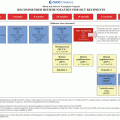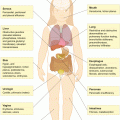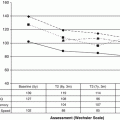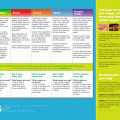© Springer New York 2015
Grace A. Mucci and Lilibeth R. Torno (eds.)Handbook of Long Term Care of The Childhood Cancer SurvivorSpecialty Topics in Pediatric Neuropsychology10.1007/978-1-4899-7584-3_1818. Resiliency in Childhood Cancer Survivors: A Clinician’s Perspective
(1)
Center for Cancer Counseling, 1000 Quail Street # 187, Newport Beach, CA 92660, USA
Keywords
ResiliencySurvivorshipProtective factorsAdaptive functioningDevelopmentalCognitive therapy18.1 Introduction
The patients who walk into my office present with a multitude of problems. The survivors of childhood cancer and their parents all have several things in common: they are actively trying to navigate through life after cancer, and develop happy, successful, fulfilled lives, as well as satisfying relationships with each other. Parents are often times confused and taken aback by the presence of problems that may be connected to long-term consequences of the treatments, and they can certainly feel unprepared to deal with them. Survivors frequently are unaware that the symptoms they are experiencing are connected to the side effects from the treatment, and subsequently are not likely to implement the most effective management tools.
As clinicians, our role involves teaching and coaching the survivors and their family members on how to achieve their common goals. The clinical work is a combination of healing and growth. It allows for a safe place to identify and acknowledge the pain, trauma, and struggles of having a diagnosis of cancer, having endured the grueling diagnostic tests and treatment regimens, transitioning from patient to survivor, and dealing with the emotional, psychological, physical and cognitive side effects from the treatments and the lifelong issues of survivorship. All the while, they must encourage the reframe and development of new and appropriate expectations for life goals, and what I later describe as “resiliency.” For many parents, psychotherapy is their first real opportunity to process the trauma and pain of having experienced their child suffer through the diagnostic process and cancer treatments. Significant survivor parental discussions include: education on how the cancer treatments have impacted their child’s developmental process, issues around their child’s self identity, which may now include a self-image of being a cancer survivor, and what meaning and consequences may be attached to that label, the impact of any ongoing physical changes, and how parenting styles and attitudes can be affected by being a family of childhood cancer survivors. Because childhood cancer has an enormous impact on the infrastructure of a family, it can challenge one’s parenting notions and values. Working together as a cohesive team (clinician, survivor, parents and family members), we set a framework and put in place tools and skills that these children and their parents can use for a lifetime.
Having worked with children and families for many years, I’m known for my ability to “pull a rabbit out of a hat.” I create sessions in which reframing, changing agendas, setting limits, handing out homework assignments, playing games, having serious discussions, tolerating lots of tears, pain, yelling, and laughing result in the acceptance of new perspectives and insights. With these creative interventions, and a basic belief that we can accomplish anything, symptom relief is always in the forefront. I am relentless in finding ways to meet these goals and will not settle for less than an agreed upon satisfactory result. My love and enjoyment for my work, these patients and their parents is contagious. The therapeutic interactions that I employ encompass the cognitive attitudes, beliefs, and tools that formulate the basis for the operational definition of resiliency presented in this chapter. These interactions afford survivors and their parents an opportunity to experience and try out new ways of thinking and responding. The more successful these interactions are, the more reinforcing they become outside of the clinical setting.
This chapter is organized to offer a clinically applicable framework in which to discuss the most effective ways of working with childhood cancer survivors and their parents in building and enhancing resiliency. The discussion involves the review of effective treatments and research which addresses the struggles and challenges of survivorship, identifying the protective factors and strengths which are most useful in dealing with adverse life situations, and discussing the theories that propose models for resiliency and adaptive functioning, combined with the wealth of information shared by survivors and family members within the clinical settings.
As clinicians, it is expected that our work is grounded in theory, research, practical clinical experience, and effective treatment strategies. Our success is dependent on our ability to communicate this knowledge in ways that are clear and easily understandable for our patients. In discussing theory and treatment strategies I will try to stay as true to this as possible. Although using jargon is easy to fall into, our task is to translate that jargon into usable, concrete concepts and examples. It is in these easy-to-understand translations and examples that our patients learn the “when” to use and apply tools and skills, the “why” these tools and skills are important and relevant, and the “how” these tools and skills actually improve life. The experience in our clinic of working through an issue in this systematic way through the organization of thoughts, problem solving, and response sets becomes a model that is replicable, for a lifetime, outside of the therapy environment.
18.2 Conceptual Framework
When children are diagnosed with cancer they are forced to deal with medical procedures that reach far beyond any imaginable stress or trauma. Parents are charged with the responsibility of being their child’s support system, their safety net, and their protector. At the same time, parents have to absorb the pain and suffering of their child, as well as their own overwhelming emotional pain and fear. For parents, there isn’t anything more difficult or heart breaking than feeling helpless in one’s ability to make the world safe for one’s children. The grueling diagnostic tests and cancer treatments that their children are forced to participate in are accompanied by overwhelming and extreme fear, anxiety, and helplessness, for both the children and their parents.
Mental health providers offer these children and their parents support, tools, and skills to help them manage through this medical crisis. During the active phase of treatment, parents are focused on getting through the treatments with the fewest medical problems and complications, just wanting and waiting for the day that their child is back home safe and sound, alive, healthy, and finished with treatments. Children are grateful for the times and days that they can play and be with their friends again, anxiously awaiting their freedom from doctors and procedures.
As these children and families transition to life after cancer treatments, the challenges and demands change, and goals now involve dealing with the aftermath of the treatments and recovery. The issues and realities of physical, academic, emotional, behavioral, cognitive, and psychological side effects are new areas to be dealt with. Reintegrating back into school settings, peer groups, and activities can be surprisingly stressful and disappointing, especially after having longed, dreamed, and waited for the freedom to return to life as it was before treatments. In addition, regular medical follow-up visits entailing scans, blood work, and physical exams, as well as waiting for the results, are ongoing stressors that can make recovery difficult and problematic. How well children and their parents are able to navigate through these issues will depend on a concept called resiliency. Resiliency is defined by Masten [1] as: “…good outcomes in spite of serious threats to adaptation or development” (p. 228), and by Walsh [2] as “…the ability to withstand and rebound from crisis and adversity…” (p. 1). Additionally, Walsh presents the concept of family resilience, which encompasses the concept that how a family deals with a crisis is “… crucial for individual and family recovery” (p. 1) [2].
When mental health providers work from a resiliency model, they can offer education and guidance which will help maximize the entire family’s recovery by assisting them in developing a framework for successful pathways into their future. Parenting a child who has survived cancer treatments involves thinking about parenting in new and innovative ways. With support, education, and skill building, parents can learn about their child’s needs, and become empowered to fulfill their desire and need to raise emotionally, academically, and psychologically sound children.
Relevant research in the field of young adult survivors of childhood cancer, which address developmental issues and functionality, helps to increase understandings of the challenges survivors face [3, 4]. In addition, when childhood cancer survivors identify the late-effects of cancer treatments, their struggles, and emotional responses, it elevates our awareness of how young adults identify stress-related long-term consequences of their treatment. However, it is in the narratives, the stories that the survivors and their families share in the clinical setting and in interviews as found in books like Childhood Cancer Survivors; A Practical Guide To Your Future [5], where some of the most relevant information is attained.
As families transition from active treatment to survivorship, important parenting questions arise. What do I need to know? What should I be doing? What can I do? When should I ask for help? Where do I go for help? If these questions are not being asked, parents should be encouraged to start thinking in these proactive terms. Childhood cancer challenges parental role shifts from compliance with the medical team, to one of coach, treatment planner, problem solver, advocate, and therapist, in a way that is different from typical parenting. Parents cannot be expected to predict or anticipate academic, social, or psychological difficulties, or how to address them.
Clinicians can play an important role in offering a continual, comprehensive follow-up which provides ongoing support and education, for both survivor and parents, throughout their lifetime. Research by Kazak and colleagues [6] outlines the need for a “developmental trauma” model that follows patients and families from diagnosis through survivorship. Combining research and clinical findings, Kazak and colleagues propose that, “The normative and understandable experience of a trauma reaction after childhood cancer is not always a pathological response or one with singularly negative implications” (p 1102). This developmental model allows for psychosocial interventions aimed as a prevention model “…in an attempt to prevent long-term distress” [6].
18.3 Definition and Benefits of a Resiliency Framework
The goal of this chapter is to offer an operational, working definition of resiliency that is useful and successful for the challenges that survivors and their families face. For this purpose I describe resiliency as a cognitive developmental process involving a combination of attitudes, beliefs, self-talk, and life evaluations of “I can” and “I will” determination. The foundation of this approach can be found in the positive psychology theories presented by Seligman [7] and Dweck [8]. When patients adapt these attitudes and beliefs, their behaviors demonstrate effort and motivation in finding ways to live, enjoy, and succeed to their fullest capacity regardless of the physical, academic, emotional, or psychological challenges of having endured cancer treatments, and/or the possible lifelong side effects. This includes developing skills that help manage a life that includes awareness, diligence, stress, and worry that is associated with a watchful eye for future developing cancers or side effects.
This working definition encompasses the ability to enjoy things even if you are not the best, to challenge oneself to one’s personal best, to be able to see accomplishments that are not fulfilled, the way we had hoped for, as a challenge to try again, or sometimes to be satisfied with what we did accomplish, and to find the things that are good fits for us (which are usually things we enjoy and do well). Resiliency, in this definition, is personally defined by each survivor and each family member. Successful outcomes are found in family systems which develop a general sense of satisfaction in how life is managed and lived. This definition also helps survivors and parents set a framework in which to plan their lives. It can offer a picture of words that is personalized and easy to use. Putting into words these common goals and feelings empowers everyone. Placing control back into a system that had lost all control can be achieved by designing a deliberate and well thought through plan of how to move forward. For many survivors, this can be a launching pad into their new normal life as a cancer survivor.
18.4 Challenges of This Resiliency Definition
For cancer survivors, the challenge of living life with this resiliency definition and reaping its benefits requires: (1) coming to terms with the realities of the cancer experience; (2) being able to reconcile the treatment phase which involves almost complete surrender of any control and being able to identify this time of helplessness as very specific to the treatment demands; and (3) having a strong, realistic, flexible treatment plan which allows for a successful transition from patient to survivor, and the appropriate support systems to implement this plan). The helplessness that encompasses cancer treatments has the potential to be overpowering and life-lasting when it is not framed in a perspective that is cognitively manageable, putting survivors at high risk for depression, anxiety, and the disabling symptoms that accompany trauma.
18.5 Theories and Approaches That Support Resiliency
Cognitive tools that enable survivors to deal with the trauma of the cancer treatments and effectively move through life with a resiliency life-style are based in the works of Ellis & Ellis [9], Beck [10], and Seligman [7], and confirmed by such research projects as Surviving Cancer Competently Intervention Program (SCCIP) [11].
Rational Emotive Behavioral Therapy, as first presented in the 1950s by Albert Ellis [9], is based on a humanistic outlook that is enriching and self-empowering. It encourages the unconditional acceptance of one’s self, others and life, while offering a way to deal with adversity. It encourages choice, high frustration tolerance in light of human frailty and adversity, and re-education rather than removal of symptoms. Using concepts of insight, realistic perspective, reasoning, and logic, people can reconstruct their thoughts and dialogues about their lives and ultimately impact their emotions and behavioral responses. Impacting perceptions of events through words allows the possibility for emotional response to be altered, providing choices for more positive behavioral outcomes [9].
Cognitive therapy, as formulated by Aaron Beck [10], offers a therapeutic model whereby a person’s perceptions and thoughts about a specific situation influence their behavioral and physiological reaction. Under stress, thoughts can be distorted, leaving one even more distressed. Being able to identify and evaluate these thoughts while exploring alternative explanations can relieve the emotional and physiological responses of distress and lead to more successful behavioral choices [10].
Martin Seligman [7] uses these concepts as a platform in his development of learned optimism. Learned optimism is a motivational skill set that outlines ways to teach optimism to young adults and children as a way to prevent depression and enhance self-esteem. The first skill set helps children and young adults learn how to see the connections between adversity and beliefs (our thoughts about what is happening that is adverse), and consequences (negative interpretation of the event). The second step involves learning how to dispute the negative thoughts with challenging questions such as: would you interpret these beliefs in the same way for everyone? This challenge allows for the gaining of a distant perspective, which lends itself to a process he calls energization (new thoughts that help calm the system, reframe and tolerate the adversity) [7].
Carol Dweck, in her book Mindset [8], presents a theory outlining how one’s beliefs about oneself permeate just about every part of one’s life. From how you think about yourself, what you describe as your personality, to whether you are successful or prevent yourself from fulfilling your potential. She proposes that in addition to understanding your personal beliefs about yourself, learning about mindsets helps to understand others too (friends, partners, kids, bosses, and superstars in science, arts, sports, and business.) Ultimately, her goal is to teach people how to improve their lives by understanding their belief system, and changing these beliefs using the mindset skills outlined in the book [8].
18.6 Clinical Application of Cognitive Theories for Survivors
If we accept the undisputable premise that cancer, the diagnostic tests, and treatments are about as traumatic an experience a child and family can have, placing everyone in a vulnerable emotional, physical, and psychological position, the question then becomes: what helps strengthen and secure a solid emotional future for these youngsters and their families? Ultimately, it is their ability to move through the disease process and manage life afterwards, using the very skills that Ellis, Beck, and Seligman so eloquently describe. Of course, the more debilitating the after effects of cancer the more of a challenge this entails.
These cognitive theories offer cancer survivors methods of tolerating, processing, and dealing with the trauma of the treatments and any long-term side effects, while maintaining the ability to function in the world to their fullest capacity. Once survivors learn that they can control their emotional destiny by their internal dialogue, and understand that this internal dialogue of thoughts and perceptions cultivate matching emotional responses, they can be empowered with a choice about how they want to feel and how they want their lives to look. Implementing the behaviors that reflect this life attitude takes time, practice, support, and mentoring. It is difficult enough under normal conditions to make behavioral changes; given the challenges of the disease, this process can feel overwhelming.
Adopting this attitude and life view is extremely empowering and self-fulfilling. With a foundation of insight, acceptance of their experience, realistic plans and goals, acceptance of themselves in realistic terms, and focusing on the future rather than what could have been, survivors can gain control of their destiny, improving their quality of their lives. The ability to learn and use the outlined skills of accepting reality, developing insight, reframing one’s thoughts, and challenging one’s irrational beliefs, are important emotional and psychological developmental tasks, especially in light of research which suggests that a survivor’s perceptions and beliefs about treatment medical events, and its effects can impact their level of psychological distress [4, 12]. For successful outcomes in this area, having strong solid support systems (which include heath care providers, family, and friends) are identified as key factors in emotionally and cognitively managing the disease [13].
18.7 Clinical Challenges of Implementing Cognitive Tools
One challenge for survivors in the use of these cognitive tools is how emotions tend to be labeled negative and positive, and how the display of emotions and reactions to adversity can be labeled weak or strong. Although cognitive theories address a realistic evaluation of thoughts, life situations, and emotions, these labels are pervasive in the culture, potentially leaving some survivors feeling isolated, embarrassed, and ashamed when they are struggling. During the active phase of treatment, being told you are strong and using powerful superheroes is one method of helping children tolerate the treatments. But, there are times that may feel more vulnerable, and living up to these images can feel like an impossible feat. In addition, even the most well-adjusted childhood cancer survivors can struggle with issues about “why me” and grieve over lost time and the remaining side effects, as well as grieve the loss of other childhood cancer friends who did not survive [5].
Survivorship can present these children and families with the dilemma of living with contradictory thoughts and emotions. It can be very confusing to feel joy and happiness, while also sporting sadness. Learning how to live with what is perceived as contradicting thoughts and emotions requires the realization that these cognitions and their resulting emotional responses can live side by side, and can be managed.
In the clinical setting, families often report that during the active phase of treatment, mood swings are easily accepted by friends and extended family as part of the struggles of dealing with the grueling treatments. However, as the children and teens feel better, start to play, socialize, and reenter their lives in general, it can be interpreted as everything is fine and back to normal, rather than the momentary break that it is. As side effects of treatments become less noticeable, the support of outside friends and family may diminish in both time and understanding of any long term emotional or psychological stress. Therefore, the emotions that linger in survivorship are more difficult to explain and understand. For children and teens, behaviors that may demonstrate these emotions can be misinterpreted as laziness, day-dreaming, defiance, anger, or oppositionality. For the children that look and sound as if everything is fine, it is equally, if not more important, to have a communication system that allows for their inner most thoughts and feelings to be expressed. Adolescence, in and of itself, has its own developmental and social challenges. If stressful behaviors are demonstrated in externalizing responses, for example angry outbursts and defiance, it is easy to recognize and deal with. However, when adolescent survivors “look fine” and appear problem free, we can’t assume that they are not distressed or internalizing their sad and disappointing emotions or struggling with issues like body image, self-perception, and social interactions [14, 15]. Survivorship can be complicated and complex and present a confusing picture [5]. Being knowledgeable and respectful of the cancer experience, from diagnosis through survivorship, provides an awareness that highlights the need for evaluating the emotional status of these youngsters, so that if they are struggling, they are not left alone suffering in silence.
During active treatment, behavioral interventions such as hypnosis, self imagery, distraction, and emotive imagery (fantasy) are effective methods used with youngsters to help them tolerate and reduce the pain and anxiety that accompanies grueling cancer treatments [16]. In the clinical setting, we sometimes face a more subtle problem when the very cognitive tools of self-hypnosis and imagination that helped survivors through grueling cancer treatments become the very cognitive processes that isolate them from their peers. We see this happen when children deal with socially difficult situations by isolating, withdrawing, daydreaming, and fantasizing, as a way to retreat to some internal safe place when life feels overwhelming. Although using these cognitive tools can be very helpful in decreasing anxiety or distress from uncomfortable situations, developmentally learning how to tolerate some distress of everyday life and incorporate skills that allow for continued interaction, rather than withdrawal, is essential for positive interactions and relationships.
Observational research on childhood survivor’s quality of close friend interactions outlined their vulnerability toward disengagement during stressful play times [17]. Observing childhood survivor’s difficulty dealing with uncertain or negative affect situations makes us aware of how this disengagement, if left unchecked, can lead to social isolation. The research addresses how survivors can struggle with sustaining play periods when they are faced with stressful feelings, and suggests that the subtle differences in peer play may not be as apparent to teachers and parents when questioned about social interactions as is the expression of negative affects [17].
Stay updated, free articles. Join our Telegram channel

Full access? Get Clinical Tree







